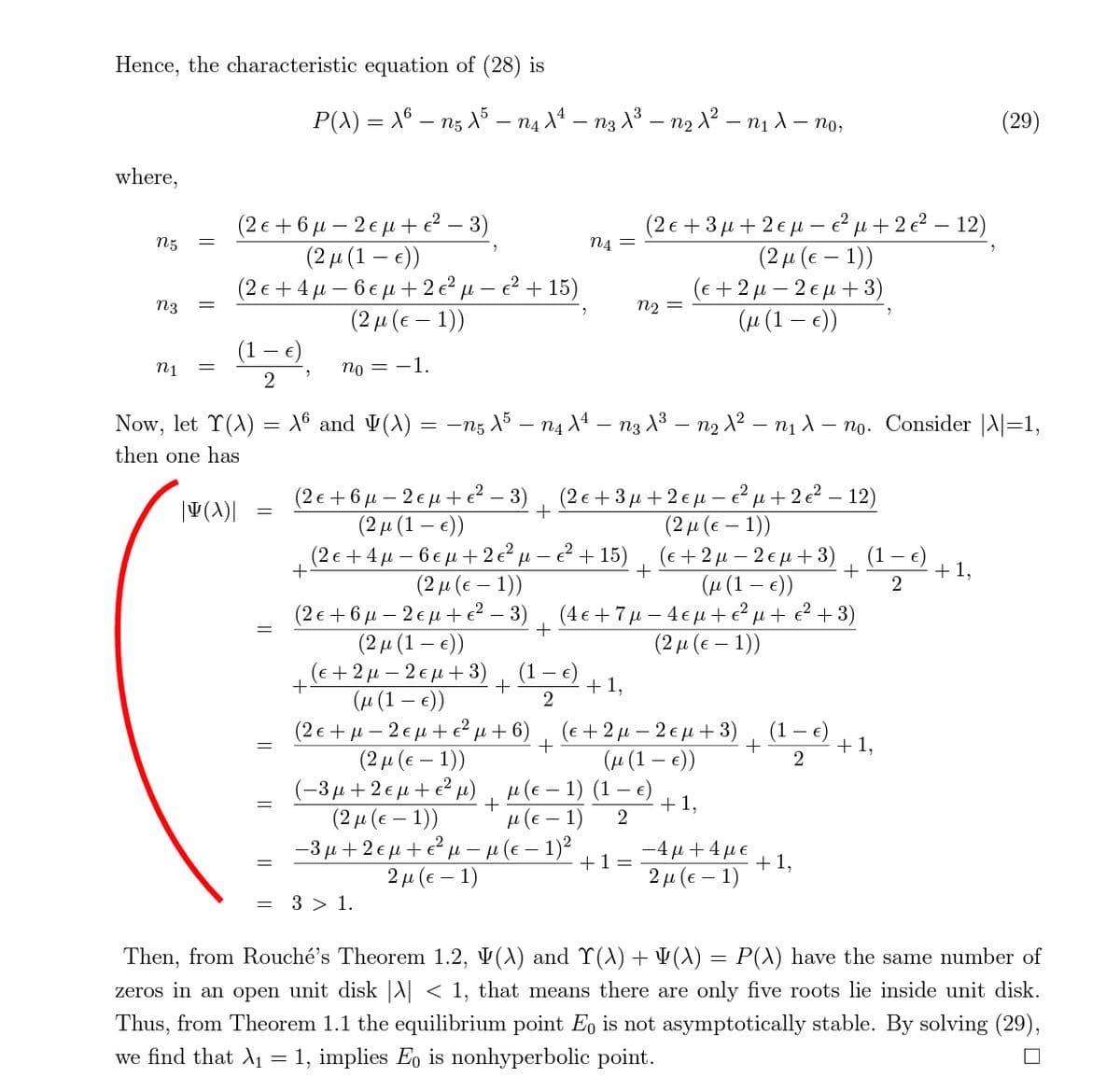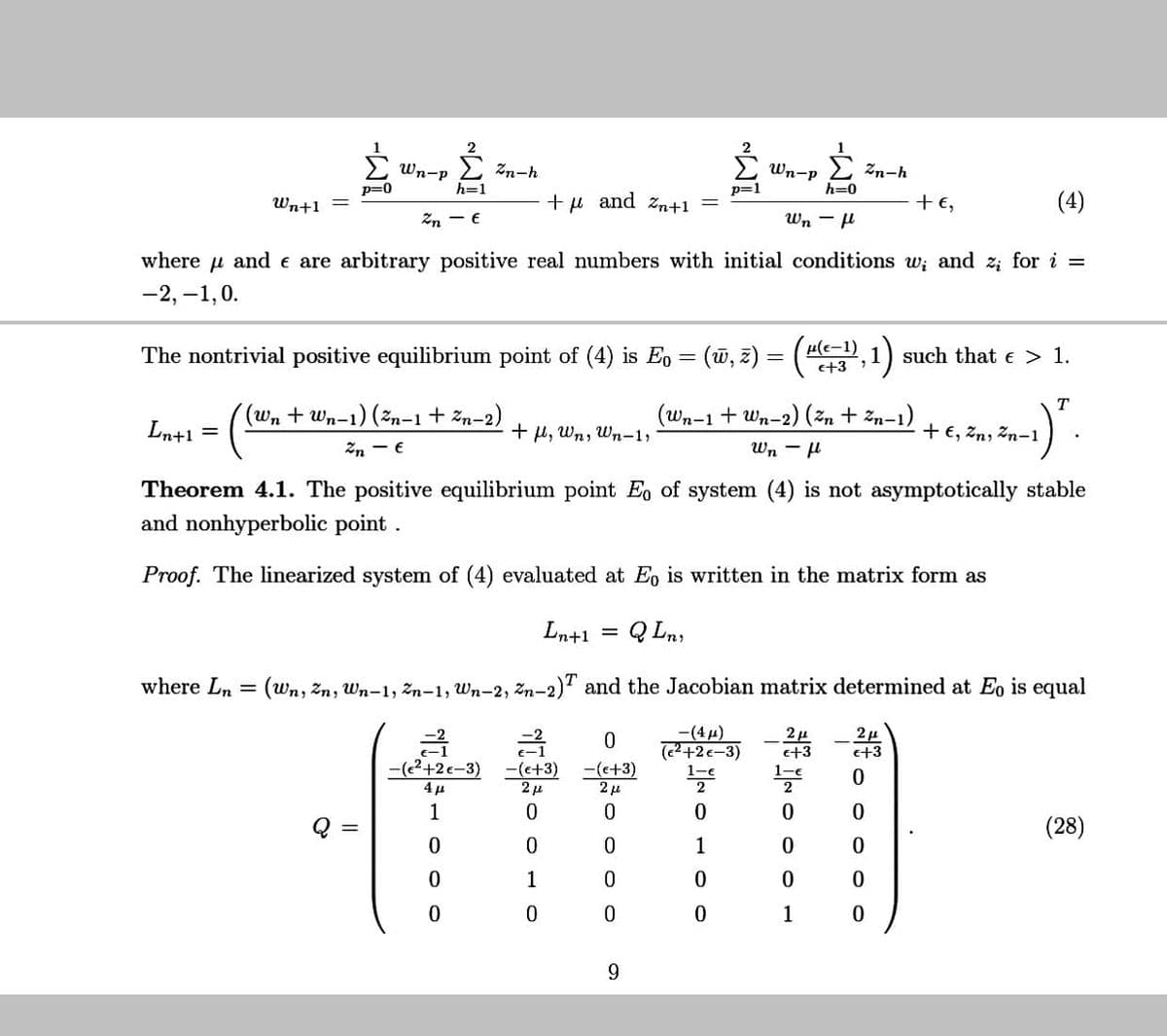Hence, the characteristic equation of (28) is P(A) = X® – nz X³ – na X* – n3 X³ – n2 X² – nd – no, (29) - nA where, (2ε+6μ-2εμ+ &-3) (2 µ (1 – e)) (2ε+4μ-6εμ+2 έμ-+15) (2μ (ε- 1)) (2ε+3μ +2 εμ- μ+2@-12 (2 µ (e – 1)) n5 n4 = (E+2μ-2εμ+3) n2 = n3 (µ (1 – e)) n1 no = -1. Now, let T(A) = 1® and V(A) = -ng 15 – n4 X4 – ng 13 – n2 X² – n1 A – no. Consider |A|=1, then one has (2ε+6μ-2εμ + ε23) (2μ (1 - 0) ) (2e+4μ-6εμ+2ε μ-+15) (2μ (ε - 1) (2ε+3μ +2εμ- μ+2 22-12) (2μ (ε -1) ) (ε+2μ-2εμ+3) (µ (1 – €)) %3D (1– +1, 2 + (2ε46μ-2εμ + 2-3) (4ε+7μ-4εμ+ θμ + +3) (2 µ (1 – €)) (e + 2µ – 2 e µ +3) (1– e) (и (1 — е)) (2 e + µ – 2 €u + e² µ+ 6) , (e +2µ – 2 €µ+3) , (1– e) (2μ (ε - 1) ) (-3μ+2εμ + μ) μ(ε-1) (1-) (2 µ (e – 1)) –3 µ +2 € µ+ e² µ –µ(e – 1)² 2 и (е — 1) (2 µ (e – 1)) +1, + 1, (H (1 – €)) +1, %3D µ(E – 1) -4μ+4με + 1, +1 = 2µ (e – 1) = 3 > 1. Then, from Rouché's Theorem 1.2, V(A) and Y(A) + ¥(A) = P(^) have the same number of zeros in an open unit disk |A| < 1, that means there are only five roots lie inside unit disk. Thus, from Theorem 1.1 the equilibrium point Eo is not asymptotically stable. By solving (29), we find that 1, implies Eo is nonhyperbolic point.
Hence, the characteristic equation of (28) is P(A) = X® – nz X³ – na X* – n3 X³ – n2 X² – nd – no, (29) - nA where, (2ε+6μ-2εμ+ &-3) (2 µ (1 – e)) (2ε+4μ-6εμ+2 έμ-+15) (2μ (ε- 1)) (2ε+3μ +2 εμ- μ+2@-12 (2 µ (e – 1)) n5 n4 = (E+2μ-2εμ+3) n2 = n3 (µ (1 – e)) n1 no = -1. Now, let T(A) = 1® and V(A) = -ng 15 – n4 X4 – ng 13 – n2 X² – n1 A – no. Consider |A|=1, then one has (2ε+6μ-2εμ + ε23) (2μ (1 - 0) ) (2e+4μ-6εμ+2ε μ-+15) (2μ (ε - 1) (2ε+3μ +2εμ- μ+2 22-12) (2μ (ε -1) ) (ε+2μ-2εμ+3) (µ (1 – €)) %3D (1– +1, 2 + (2ε46μ-2εμ + 2-3) (4ε+7μ-4εμ+ θμ + +3) (2 µ (1 – €)) (e + 2µ – 2 e µ +3) (1– e) (и (1 — е)) (2 e + µ – 2 €u + e² µ+ 6) , (e +2µ – 2 €µ+3) , (1– e) (2μ (ε - 1) ) (-3μ+2εμ + μ) μ(ε-1) (1-) (2 µ (e – 1)) –3 µ +2 € µ+ e² µ –µ(e – 1)² 2 и (е — 1) (2 µ (e – 1)) +1, + 1, (H (1 – €)) +1, %3D µ(E – 1) -4μ+4με + 1, +1 = 2µ (e – 1) = 3 > 1. Then, from Rouché's Theorem 1.2, V(A) and Y(A) + ¥(A) = P(^) have the same number of zeros in an open unit disk |A| < 1, that means there are only five roots lie inside unit disk. Thus, from Theorem 1.1 the equilibrium point Eo is not asymptotically stable. By solving (29), we find that 1, implies Eo is nonhyperbolic point.
Advanced Engineering Mathematics
10th Edition
ISBN:9780470458365
Author:Erwin Kreyszig
Publisher:Erwin Kreyszig
Chapter2: Second-order Linear Odes
Section: Chapter Questions
Problem 1RQ
Related questions
Question
Show me the determine red and all information is here

Transcribed Image Text:Hence, the characteristic equation of (28) is
P(A) = X° – ng X* – na X* – n3 X³ – n2 1² – n1 1 – no,
(29)
-
where,
(2ε+6μ-2εμ + -3)
(2μ (1 - e)
(2ε+4μ =6εμ# 2 μ- 2+ 15 )
(2μ (ε-1) )
(2ε+3μ+2 εμ- έμ+ 222-12)
n5
n4 =
(2μ (ε - 1) )
(ε+2μ-2εμ + 3)
n2 =
n3
(µ (1 – )
(1 – e)
n1
no = -1.
Now, let T(A) = 16 and V(A) = -nz 15 – n4 X4 – n3 13 – n2 X? – nị 1 – no. Consider |A|=1,
then one has
(2ε+6μ-2 εμ # ε- 3)
(2 μ (1-)
(2ε+ 3μ + 2 εμ - ε?μ + 22-12 )
(2μ (ε - 1)
( E+2μ-2εμ# 3)
(µ (1 – e))
(4ε+7μ-4εμ + ε'μ + 243)
(2μ (ε-1))
(2ε+4μ = 6εμ+ 2 μ - ?+ 15)
+
(1 – €)
+
+ 1,
(2 μ (ε - 1) )
(2ε + 6μ = 2εμ + ε? - 3)
(2μ (1 - ε) )
( ε+2μ-2 εμ+3)
(и (1 — е))
(2ε+μ-2εμ+ μ+6)
(2μ (ε -1) )
2
(1 €)
+ 1,
(e + 2 µ – 2 € µ + 3)
(1
(и (1 — е))
+1,
2
(-3μ +2εμ+' μ) μ (ε-1) (1-e)
+ 1,
(2 μ (ε- 1) )
н (€ — 1)
-3 u +2 € u + e? µ - µ (e – 1)2
-4μ+4με
+ 1,
2 µ (e – 1)
+1=
2μ (ε- 1)
= 3 > 1.
Then, from Rouché's Theorem 1.2, V(A) and Y(A) + ¥(A) = P(X) have the same number of
zeros in an open unit disk |A| < 1, that means there are only five roots lie inside unit disk.
Thus, from Theorem 1.1 the equilibrium point Eo is not asymptotically stable. By solving (29),
we find that A1 = 1, implies Eo is nonhyperbolic point.

Transcribed Image Text:Σ
1
E zn-h
Wn-p
h=0
Wn-p
Zn-h
h=1
p=0
p=1
Wn+1
+µ and zn+1
+ €,
(4)
Zn - €
Wn - H
where u and e are arbitrary positive real numbers with initial conditions w; and z; for i =
-2, -1,0.
The nontrivial positive equilibrium point of (4) is Eo = (w, z) = ( ,1) such that e > 1.
µ(e-1)
e+3
T
(Wn + Wn-1) (zn-1 + Zn-2)
(Wn-1 + Wn-2) (žn + žn-1)
Ln+1 =
+ l, Wn, Wn-1,
+ €, Zn, Zn-1
Zn - €
Wn - µ
Theorem 4.1. The positive equilibrium point E, of system (4) is not asymptotically stable
and nonhyperbolic point .
Proof. The linearized system of (4) evaluated at Eo is written in the matrix form as
Ln+1
Q Ln,
where Ln
(Wn, 2n, Wn-1, žn-1, Wn-2, zn-2) and the Jacobian matrix determined at Eo is equal
금
-(44)
(e+2e-3)
e+3
e+3
-(e2+2e-3)
4 µ
-(e+3)
2 u
-(c+3)
1-e
2
(28)
1
1
1
9.
O O
Expert Solution
This question has been solved!
Explore an expertly crafted, step-by-step solution for a thorough understanding of key concepts.
Step by step
Solved in 6 steps

Recommended textbooks for you

Advanced Engineering Mathematics
Advanced Math
ISBN:
9780470458365
Author:
Erwin Kreyszig
Publisher:
Wiley, John & Sons, Incorporated

Numerical Methods for Engineers
Advanced Math
ISBN:
9780073397924
Author:
Steven C. Chapra Dr., Raymond P. Canale
Publisher:
McGraw-Hill Education

Introductory Mathematics for Engineering Applicat…
Advanced Math
ISBN:
9781118141809
Author:
Nathan Klingbeil
Publisher:
WILEY

Advanced Engineering Mathematics
Advanced Math
ISBN:
9780470458365
Author:
Erwin Kreyszig
Publisher:
Wiley, John & Sons, Incorporated

Numerical Methods for Engineers
Advanced Math
ISBN:
9780073397924
Author:
Steven C. Chapra Dr., Raymond P. Canale
Publisher:
McGraw-Hill Education

Introductory Mathematics for Engineering Applicat…
Advanced Math
ISBN:
9781118141809
Author:
Nathan Klingbeil
Publisher:
WILEY

Mathematics For Machine Technology
Advanced Math
ISBN:
9781337798310
Author:
Peterson, John.
Publisher:
Cengage Learning,

